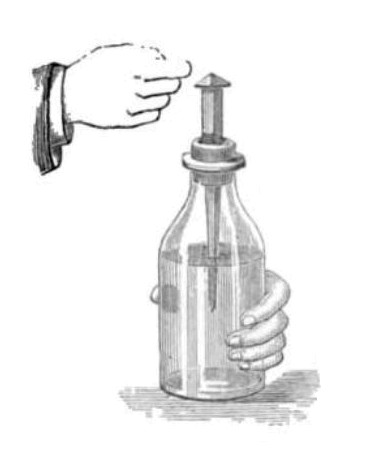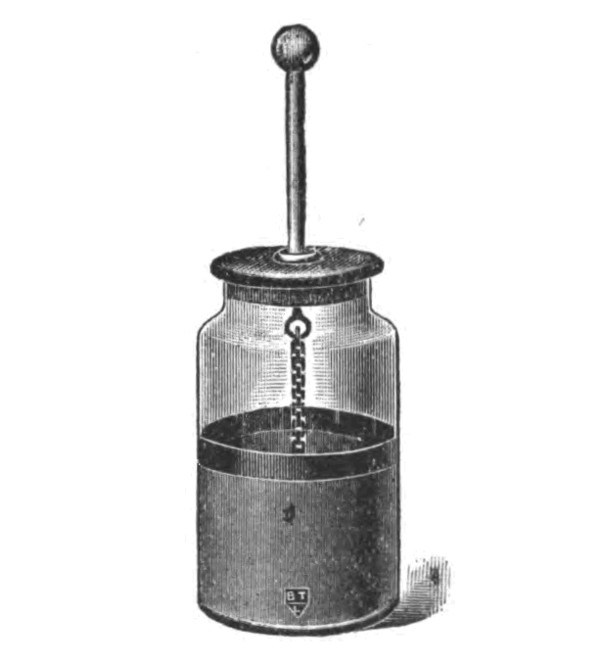Leyden jar (Electrical Component) AKA Leiden jar

Leyden jar
1746 AD - 1749 AD
AKA Leiden jar
A Leyden jar is an antique piece of physics apparatus that can store electric charge; it was the first form of capacitor.
It consists of a glass jar coated on the inside and outside with metal foil. The foils stop well short of the mouth of the jar so that the charge can't arc between the foils through the mouth. A brass rod electrode pierces the wooden stopper and extends into the jar, and from it hangs a metal chain which makes contact with the inner foil. The jar is charged by grounding the outside foil and applying electricity from an electrostatic machine to the electrode.
The Leyden jar is a high voltage device; it is estimated that at a maximum the early Leyden jars could be charged to 20,000 to 60,000 volts. The center rod electrode has a metal ball on the end to prevent leakage of the charge into the air by corona discharge. It was first used in electrostatics experiments, and later in high voltage equipment such as spark gap radio transmitters and electrotherapy machines.
Events (2)
for 
Attachments
Water-filled Leyden jar Drawing of an early form of Leyden jar, from an 1898 textbook on physics. Unlike the later type of Leyden jar which had coatings of metal foil on the inside and outside, this first form of Leyden jar was filled with water; the water formed the inner plate of the capacitor. A metal nail driven through the cork stopper made contact with the water, allowing the water to be charged with electricity and discharged. The jar was held in the hand, and the (grounded) hand on the outside of the jar formed the other plate of the capacitor. Once charged, the jar could be discharged by approaching the nail with a finger as shown. The charge from the water would jump via a spark to the hand, and flow through the body to the other hand holding the jar, neutralizing the opposite charge there. This often resulted in a nasty shock.
Metal foil Leyden jar Drawing of a Leyden jar, a piece of antique scientific apparatus used to store electric charge, from a 1919 physics textIt consists of a glass jar with tin foil coating the outside and inside surfaces. A brass electrode pierces the stopper, with a hanging chain attached which makes contact with the inner foil, so the jar can be charged. In use, the outside of the jar is connected to ground, and the central electrode is attached to a high voltage electrostatic machine. A large charge of static electricity accumulates on the inner foil, and an opposite polarity charge accumulates on the outer foil. If a wire connected to the outer foil is brought near the central electrode, a spark will jump, discharging the jar. The foil linings stop well short of the mouth of the jar so the charge on the foils can't discharge by arcing through the mouth. The glass was usually shellacked before applying the foil, because bare glass forms a partially conductive hygroscopic coating which tended to discharge the jar.
"Dissectible" Leyden jar Drawing of a "dissectible" Leyden jar, from 1876 physics book. This experimental apparatus, invented by American statesman and scientist Benjamin Franklin, was used to illustrate an erroneous belief that the charge on a Leyden jar does not reside on the metal plates, but on the glass jar dielectric. The jar was assembled and charged with electricity. If the jar was then disassembled into its parts, it was found that the parts were not charged and could be handled without creating a spark. However, if the jar was then reassembled, a spark could be obtained between the inner and outer metal plates. This was supposed to show that the charge in Leyden jars, and all capacitors, is stored in the dielectric, not the metal plates. However, it is now known that this was a special effect caused by the high voltage on the Leyden jar. When the jar is disassembled, the charge is deposited on the glass by corona discharge. Handling does not remove much of the charge, so when the jar is reassembled there is enough left to cause a spark. In general the charge in capacitors such as Leyden jars is stored on the plates.











